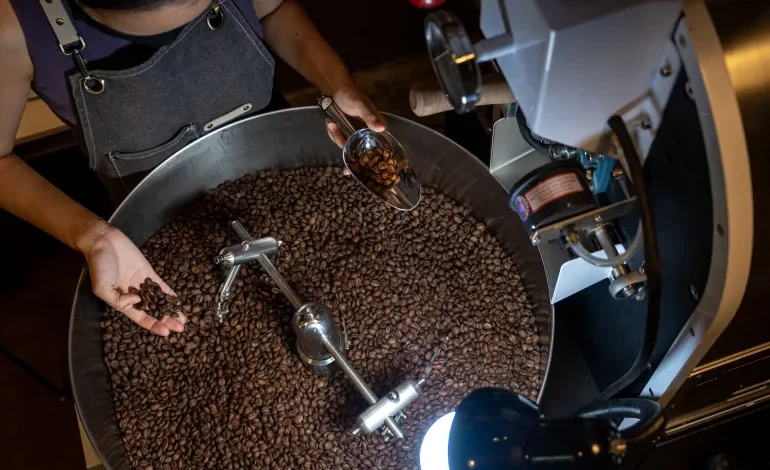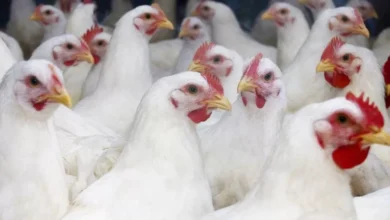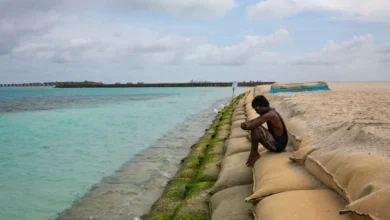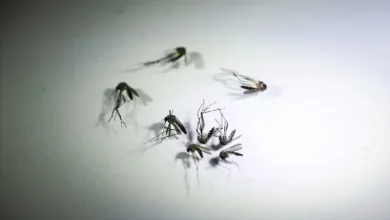Coffee’s in danger: Can Vietnam’s Robusta save it from climate change?

The white-walled room in a house on the outskirts of Buon Ma Thuot, Vietnam’s coffee capital, is quiet. The only thing breaking the silence is the occasional beep of an electronic scale, or the sound of coffee being poured into a measuring glass. A handful of people, all wearing white lab coats, concentrate on their work.
“This is really a lab,” says Nguyen Van Hoa, as he walks around the room in the white lab coat he wears over his jeans and trainers. A young man, Hoa calls himself a “green bean hunter” and is the owner of Stone Village Lab and Education, a company that researches and sources high-quality coffee beans for cafes and coffee businesses.
Now and then, he stops at a desk to demonstrate how many beans to add to each cup and the ideal water temperature. Baristas and cafe owners come here from all over the country to learn about coffee, from the capital Hanoi in the north to Ho Chi Minh City in the south.
He holds out a cup with a small serving of dark brown coffee brewed from a blend he has been working on for seven years. “It will change the mind of anyone who thinks that you cannot make good coffee from Robusta,” he says.
This – changing the minds of the many Robusta sceptics – is what has occupied Nguyen Van Hoa for the past few years. In the coffee industry, Robusta is known as the inferior sibling of Arabica, lacking the latter’s complexity and sweeter, smoother notes. Robusta is almost always mass-produced and cheap.
“The Robusta market is only looking for the best price. But we can change that,” Nguyen Van Hoa says.
They must. The Arabica coffee bean which is near-universally synonymous with quality coffee, is under serious threat from climate change. Reforming the image and quality of the much-maligned – but, as its name suggests, resilient – Robusta coffee bean is crucial for the future of coffee.
And Vietnam is where that change may well happen. It is the world’s largest producer of Robusta – and second to Brazil in overall coffee production, and the bean comprises 95-97 percent of all the coffee grown in the country.
This has been the case since French colonists brought coffee plants to the region in the 1850s.
“The idea was to ‘just bring the beans and the more you bring the more [money] you make’,” explains Timen Swijtink, managing partner at the coffee company Lacaph in Ho Chi Minh City.
In the decades that followed, coffee plantations grew in popularity. After Vietnam’s first commercial coffee processing plant was built in 1950, the industry continued to expand.
Then, in 1986, Vietnam introduced Doi Moi (“reinvention”), which shifted the country’s post-war economic focus to be more market oriented. Since then, the country’s annual coffee bean production has exploded, up from 18,400 tonnes to more than 1.9 million tonnes.
Today, 90 percent of Vietnam’s coffee is grown around Buon Ma Thuot, on the Central Highlands plateau, between 500 metres (1,640 feet) and 800 metres (2,625 feet) above sea level. Here, in every direction, vast fields of bright green coffee plants stretch into the horizon. In the autumn, the small cherries, which are about the size of grapes and grow in bunches, weigh down the branches and change from green to red – a sign that they are ready for harvest.
‘The plants are happy together’
Just south of Buon Ma Thuot, not far from Nguyen Van Hoa’s coffee lab, is the Aeroco coffee plantation – eight hectares in size (20 acres) – which Anh Nguyen Tu and her husband, Le Dinh Tu, have run since 2017.
Quality is not top of the list for the big, multinational companies that turn the majority of Vietnam’s coffee beans into instant coffee for the soft drink and pharmaceutical companies that use caffeine in their products. Both buy beans cheaply and in bulk.
But at Aeroco, the focus is very much on growing “fine” Robusta. Le Dinh Tu is an agricultural engineer. Before shifting to specialty coffee, the couple provided organic fertilisers to farmers for 18 years.
“It took three years until we could survive from coffee, there are many costs involved when you want to work in a sustainable way,” says Anh Nguyen Tu.
Wearing a straw hat as protection from the afternoon sun, she walks out among the plants. She explains the growing process. “We grow in three layers. First grass, then coffee, then trees like jackfruit and pepper. This is to balance the ecosystem. The plants are happy together,” she says.
Planting this way benefits both the bushes and the land. It gives the coffee plant much-needed shade, and helps the soil retain its nutrients.
Anh Nguyen Tu picks and carefully scratches a pale red cherry with her nail to determine if it is fully ripe. If the beans are harvested too early, the coffee will not have the round and sweet aftertaste typical for quality coffee. “These cherries need a bit more time,” she says, then walks towards an open space where a group of employees are gathering beans which had been laid out on canvases in the sun.
It’s a time-consuming process. To properly dry and ferment the beans, they must be turned every 30 minutes, and then brought indoors in the afternoon. “I had no idea how patient you must be when growing coffee,” says Pham Thi Duyen, one of the workers. She wears a green shirt, just like the others in the team, most of whom are women.
“I realise it now, when doing it with my own hands,” she says.
Most coffee grown at Aeroco is Robusta. The couple also runs a smaller Arabica plantation in Kon Tum, a couple of hours away, at a slightly higher altitude. Arabica plants need more elevation than Robusta bushes to grow well: at least about 800 metres (2,625 feet) above sea level, but preferably higher, up to 1,500 metres (5,000 feet). At such altitudes, the air is cooler, and the beans grow more slowly, which allows time to develop more flavour.
Typically, Robusta beans are mass-produced. Harvesting happens just once, which means many unripe and damaged cherries end up in the mix, and the beans are then left to dry on the ground. At Aeroco, beans are hand-picked multiple times to ensure that only the ripe cherries are picked each time.
The process may lower productivity, “but the quality is incomparable”, Anh Nguyen Tu says.
‘Roast it dark, serve it strong’
At Cheo Leo, an iconic family-run cafe on a small backstreet in Ho Chi Minh City, a waiter brings out glass after glass with a few centimetres of dark, glimmering coffee.
“We roast it dark and serve it strong,” he says.
Vietnam has a unique way of brewing coffee called “phin”. First, a perforated metal filter plate is placed on top of a glass or mug. A few tablespoons of finely ground beans are added to the reusable metal brew chamber, which sits on the filter plate. A gravity chamber is pressed down on top of the coffee, before hot water is poured over top. This process allows the coffee to slowly drip downward into the glass, enhancing its flavour.
The dark, aromatic drink can be served either hot (“ca phe nong”) or with ice (“ca phe da”), and often with sweetened, condensed milk.
Phin coffee is without exception made from Robusta. And because the beans are generally low quality, they’re often roasted with other ingredients – such as butter, soy sauce, sugar or vanilla – to add flavour.
“This started 50-60 years ago, when the country was poor, and no one could afford quality beans. Now, people have gotten used to the taste and still prefer it,” explains Julien Nguyen, the young owner of the cafe Tonkin Cottage in Ho Chi Minh City.
Until recently, this was the story of Vietnam’s Robusta. But things are changing.
With some growers now treating the cultivation of Robusta as they would Arabica, the bar is being raised. Countries such as Uganda, India and Indonesia now produce specialty Robusta
Climate change has been a big factor. Robusta tolerates higher temperatures – typically 22 – 30 degrees Celcius (72 – 86 degrees Fahrenheit) – than Arabica – typically 15C – 20C (59 – 68F) – and is more resistant to disease, insects and funguses. Studies have shown that by 2050 as much as 50 percent of the land used to grow Arabica today might be unsuitable for production.
The global coffee industry will have to transform itself – that means growing Robusta in new locations and producing a higher-quality product.
“The industry understands this. But it is also in shock,” says Juan Pablo Solis, senior adviser on climate change and environment at Fairtrade International, which helps farmers and workers achieve better working conditions and fair value for their products. “Everyone is trying to prepare themselves for these challenges.”
Coffee’s global landscape may change. “Coffee is a fragile plant that requires a certain micro-climate to thrive. In the future, it will disappear from some countries,” explains Solis.
“People will still demand coffee and some countries will continue producing lower quality coffee in massive volumes,” Solis says. However, he adds, there will also be smaller plantations focused on producing high-quality coffee.
Research by Global Change Biology, the environmental change journal, shows that production of Arabica is expected to decline by 50 percent by 2088 because of rising global temperatures.
The world is already seeing signs of this. Severe drought in Brazil in 2021, for example, cut the annual crop that year by one-third.
Robusta will be more resilient to the effects of climate change – although experts caution that more research is needed to understand its limitations.
, with several varieties scoring more than 80 points out of 100 on the Specialty Coffee Association’s chart, the industry’s benchmark. Scoring 80 points or higher on this index classifies a coffee as “specialty” and gives it a rating of “very good”. Higher than 85 is “excellent” while scoring 90 or more is “outstanding”.











